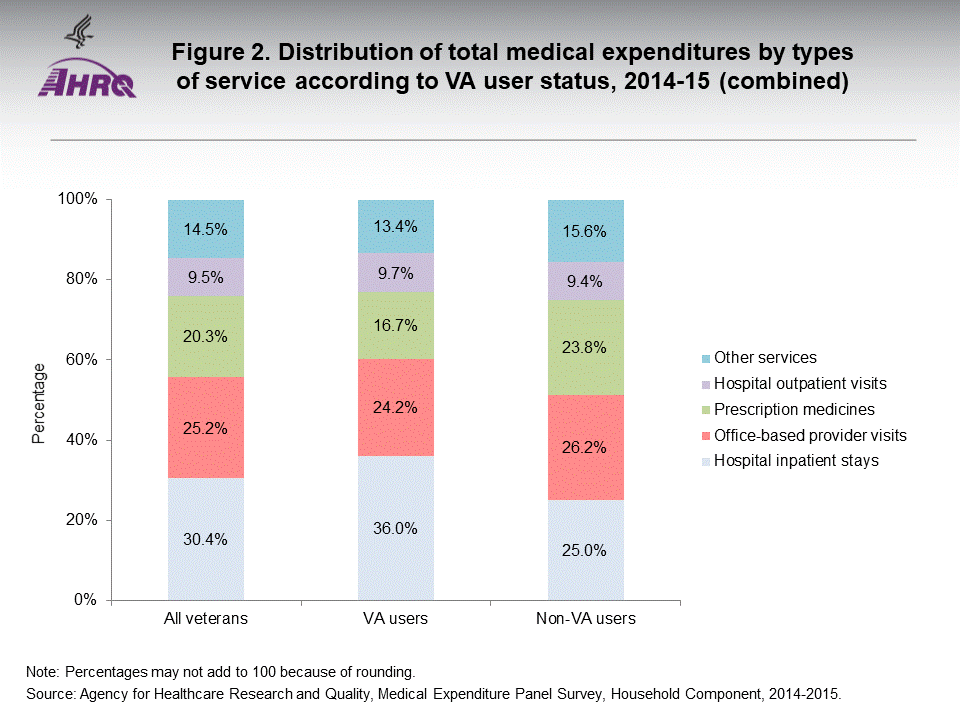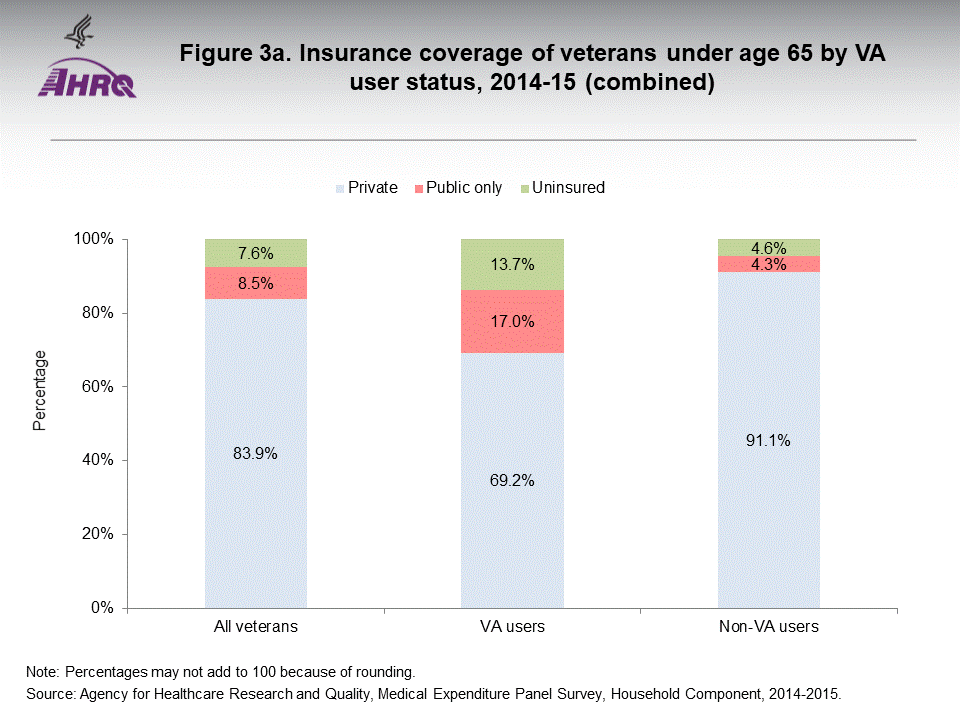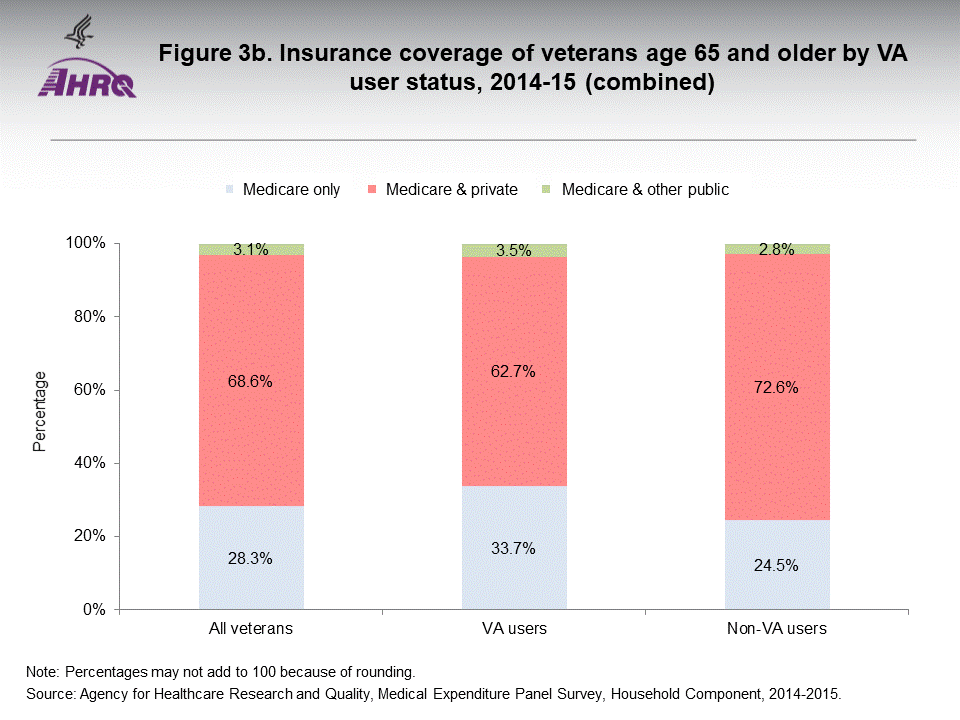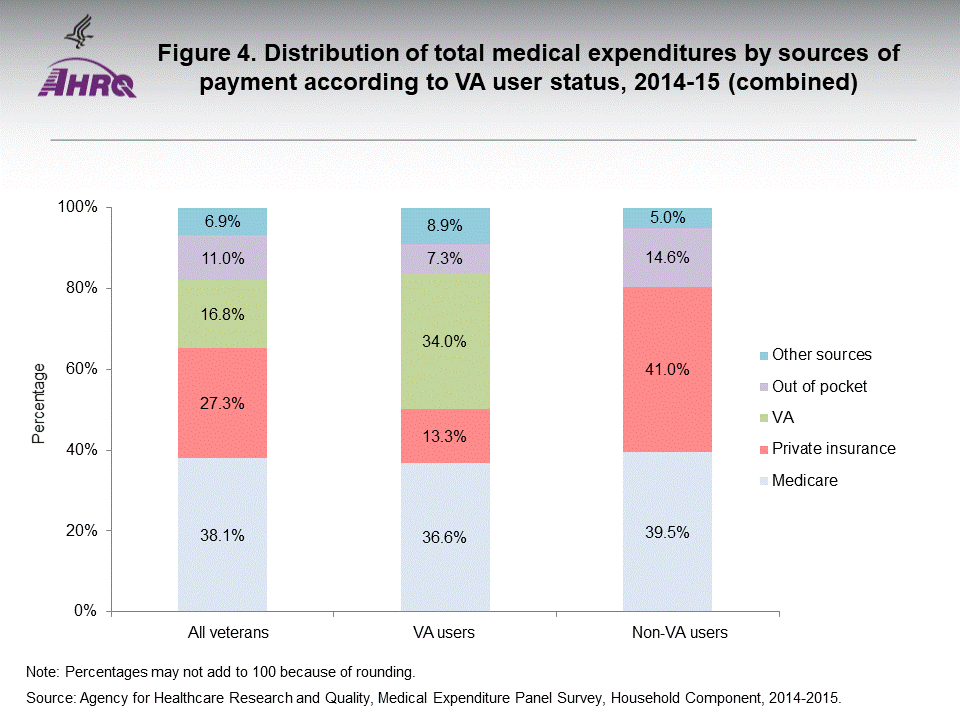Skip to main content
|
||||||||||||||||||||||||||||||||||||||||||||||||||||||||||||||||||||||||||||||||||||||||||||||||||||
|
|
||||||||||||||||||||||||||||||||||||||||||||||||||||||||||||||||||||||||||||||||||||||||||||||||||||
STATISTICAL BRIEF #508:
|
||||||||||||||||||||||||||||||||||||||||||||||||||||||||||||||||||||||||||||||||||||||||||||||||||||
| January 2018 | ||||||||||||||||||||||||||||||||||||||||||||||||||||||||||||||||||||||||||||||||||||||||||||||||||||
|
Steven R. Machlin, MS and Pradip Muhuri, PhD |
||||||||||||||||||||||||||||||||||||||||||||||||||||||||||||||||||||||||||||||||||||||||||||||||||||
Highlights
|
||||||||||||||||||||||||||||||||||||||||||||||||||||||||||||||||||||||||||||||||||||||||||||||||||||
IntroductionBased on data from the 2015 Medical Expenditure Panel Survey Household Component (MEPS-HC), nearly one-fifth of U.S. veterans’ expenditures for health care was paid by the Department of Veterans Affairs (VA). In general, eligibility for VA-covered health care requires that a veteran have served in the military for at least 24 months, received an honorable discharge, and met certain criteria with respect to service-connected disability rating, income, and other factors.Understanding differences between veterans who use the VA health system and those who do not can be helpful in the planning and targeting of health resources for the nation’s veterans.1 This Statistical Brief uses pooled data for 2014 and 2015 from the MEPS-HC to compare various demographic characteristics, health insurance status, and health expenditures (see Definitions for a description of “expenditures”) of VA health system users (hereafter referred to as VA users) to other veterans who received only care that was not covered by the VA (hereafter referred to as non-VA users). The estimates presented in this Brief are for the 91.9 percent of veterans in 2014–15 with medical expenditures (about 17.1 million persons on average per year),2 of whom 37.1 percent were VA users and 62.9 percent were non-VA users. VA users are defined as those with some of their medical expenditures paid by the VA while non-VA users comprise veterans for whom none of their expenditures were paid by the VA in 2014–15. Only differences between these groups that are statistically significant at the 0.05 level or better are described in the text. |
||||||||||||||||||||||||||||||||||||||||||||||||||||||||||||||||||||||||||||||||||||||||||||||||||||
FindingsCharacteristics (table 1)Compared to non-VA users, VA users were more likely to be elderly (58.7 versus 51.1 percent), more likely to be non-Hispanic black (14.1 versus 9.6 percent) and less likely to be non-Hispanic white (75.3 versus 80.9 percent). Moreover, VA users were approximately twice as likely as their non-VA user counterparts to be poor/near poor (15.1 versus 7.9 percent) or low income (16.9 versus 7.9 percent) and twice as likely to be reported in fair or poor health (26.1 versus 12.7 percent). VA users were also more likely to live in nonmetropolitan areas (21.8 versus 15.5 percent of non-VA users). Health care expenditure levels (figure 1) The overall mean annual total health care expenditure per veteran in 2014–15 was $9,338. However, mean expenditures were about 65 percent higher for VA users than non-VA users ($12,411 versus $7,525). Median expenditures (i.e., midpoint level) were substantially lower than means for both groups but nearly twice as large for VA users as non-VA users ($5,360 versus $2,777). Distribution of expenditures by type of service (figure 2) The proportion of total expenditures that was attributable to inpatient stays was higher for VA users than non-VA users (36.0 versus 25.0 percent). In contrast, the proportion of total expenditures attributable to prescribed medicines was lower for VA users than non-VA users (16.7 versus 23.8 percent). The proportion of expenditures attributable to other service categories (i.e., office-based, hospital outpatient, and other) was similar for the two groups. Health insurance coverage (figures 3a–3b) Among non-elderly veterans (i.e., those under age 65), VA users were less likely to have private insurance coverage than non-VA users (69.2 versus 91.1 percent) but were more likely to have public coverage (17.0 versus 4.3 percent for non-VA users) or be uninsured (13.7 versus 4.6 percent for non-VA users). Among elderly veterans (i.e., those age 65 and older), VA users were more likely than non-VA users to have only Medicare coverage (33.7 versus 24.5 percent) and were less likely to have both Medicare and private insurance coverage (62.7 versus 72.6 percent). Distribution of expenditures by sources of payment (figure 4) In 2014–15, the VA paid for about one-third (34.0 percent) of aggregate expenditures for VA users. While Medicare paid for just over one-third of expenditures among both VA and non-VA users (36.6 and 39.5 percent, respectively), a substantially higher proportion of expenditures for non-VA users was paid by private insurance (41.0 versus 13.3 percent for VA users). Moreover, the proportion of non-VA users’ expenditures that was paid out of pocket was twice as large as for VA users (14.6 versus 7.3 percent). |
||||||||||||||||||||||||||||||||||||||||||||||||||||||||||||||||||||||||||||||||||||||||||||||||||||
Data SourceThe estimates in this Statistical Brief are based on data from the MEPS 2015 Full Year Consolidated Data File (HC-181) and the MEPS 2014 Full Year Consolidated Data File (HC-171) combined (supplemented with information on location of residence obtained from restricted use geocoded files). These files are available at: https://meps.ahrq.gov/mepsweb/data_stats/download_data_files.jsp. |
||||||||||||||||||||||||||||||||||||||||||||||||||||||||||||||||||||||||||||||||||||||||||||||||||||
DefinitionsExpendituresExpenditures include total direct payments from all sources to hospitals, physicians, home health providers (agency and paid independent providers), dental providers, pharmacies and other types of health care providers (e.g., physical therapists, chiropractors, optometrists, etc.), and miscellaneous expenses reported by respondents in the MEPS-HC (ambulance services and glasses). Expenditures for hospital-based services include those for both the facility and separately billed physician services. Veterans with expenditures All sample persons who were reported as having been honorably discharged (HONRDC31=1 or HONRDC42=1 or HONRDC53=1) from active duty in the Armed Forces and having some medical expenditures during the year (TOTEXPyy>0) were included in the analysis. These individuals were further classified as VA users or non-VA users as follows:
Individuals under age 65 were classified in the following three insurance categories, based on household responses to health insurance status questions:
Veterans were classified into the following four groups based on the percentage of the federal poverty level for total family income (which is adjusted for family size and composition):
Based on definitions for 2013 from the Office of Management and Budget, MEPS-HC respondents who resided in counties that were part of metropolitan statistical areas (MSAs) were classified as metropolitan area residents while those residing in counties designated as micropolitan or other noncore areas were classified as nonmetropolitan residents. |
||||||||||||||||||||||||||||||||||||||||||||||||||||||||||||||||||||||||||||||||||||||||||||||||||||
About MEPS-HCMEPS-HC is a nationally representative longitudinal survey that collects detailed information on health care utilization and expenditures, health insurance, and health status, as well as a wide variety of social, demographic, and economic characteristics for the U.S. civilian noninstitutionalized population. It is cosponsored by the Agency for Healthcare Research and Quality and the National Center for Health Statistics. |
||||||||||||||||||||||||||||||||||||||||||||||||||||||||||||||||||||||||||||||||||||||||||||||||||||
ReferencesThe following publication contains extensive information on the demographics and health care needs of the current and future U.S. veteran population:Current and Projected Characteristics and Unique Health Care Needs of the Patient Population Served by the Department of Veterans Affairs. Santa Monica, CA. RAND Corporation (sponsored by the Department of Veterans Affairs), 2015. https://www.rand.org/pubs/research_reports/RR1165z1.html The following reports contain information on the survey and sample designs for the MEPS Household and Medical Provider Components (HC and MPC, respectively). Data collected in these two components are used jointly to derive MEPS health care expenditure data: Cohen, J. Design and Methods of the Medical Expenditure Panel Survey Household Component. MEPS Methodology Report No. 1. AHCPR Pub. No. 97-0026. Rockville, MD. Agency for Healthcare Policy and Research, 1997. http://www.meps.ahrq.gov/mepsweb/data_files/publications/mr1/mr1.shtml Ezzati-Rice, T.M., Rohde, F., Greenblatt, J. Sample Design of the Medical Expenditure Panel Survey Household Component, 1998–2007. Methodology Report No. 22. March 2008. Agency for Healthcare Research and Quality, Rockville, MD. http://www.meps.ahrq.gov/mepsweb/data_files/publications/mr22/mr22.shtml Machlin, S.R., Chowdhury, S.R., Ezzati-Rice, T., DiGaetano R., Goksel H., Wun L.-M., Yu W., Kashihara D. Estimation Procedures for the Medical Expenditure Panel Survey Household Component. Methodology Report No. 24. September 2010. Agency for Healthcare Research and Quality, Rockville, MD. http://www.meps.ahrq.gov/mepsweb/data_files/publications/mr24/mr24.shtml Stagnitti, M.N., Beauregard, K., Solis, A. Design, Methods, and Field Results of the Medical Expenditure Panel Survey Medical Provider Component (MEPS MPC)—2006 Calendar Year Data. Methodology Report No. 23. November 2008. Agency for Healthcare Research and Quality, Rockville, MD. http://www.meps.ahrq.gov/mepsweb/data_files/publications/mr23/mr23.shtml The following report contains information on the metropolitan/nonmetropolitan classification scheme used for this report: Ingram, D.D., Franco, S.J. 2013 NCHS Urban–Rural Classification Scheme for Counties. National Center for Health Statistics. Vital Health Stat 2(166). 2014. |
||||||||||||||||||||||||||||||||||||||||||||||||||||||||||||||||||||||||||||||||||||||||||||||||||||
Suggested CitationMachlin, S. and Muhuri, P. Characteristics and Health Care Expenditures of VA Health System Users versus Other Veterans, 2014–2015 (Combined). Statistical Brief #508. January 2018. Agency for Healthcare Research and Quality, Rockville, MD. http://www.meps.ahrq.gov/mepsweb/data_files/publications/st508/stat508.shtml |
||||||||||||||||||||||||||||||||||||||||||||||||||||||||||||||||||||||||||||||||||||||||||||||||||||
|
AHRQ welcomes questions and comments from readers of this publication who are interested in obtaining more information about access, cost, use, financing, and quality of health care in the United States. We also invite you to tell us how you are using this Statistical Brief and other MEPS data and tools and to share suggestions on how MEPS products might be enhanced to further meet your needs. Please email us at MEPSProjectDirector@ahrq.hhs.gov or send a letter to the address below: Joel Cohen, PhD, Director Center for Financing, Access, and Cost Trends Agency for Healthcare Research and Quality 5600 Fishers Lane Rockville, MD 20857 |
||||||||||||||||||||||||||||||||||||||||||||||||||||||||||||||||||||||||||||||||||||||||||||||||||||
|
1 Veterans not covered by the VA system include those who are ineligible as well as those who are eligible but do not proactively enroll. Enrollees may or may not use the VA health care system in a particular year. 2 Of the 8.1 percent of veterans excluded from the analysis, a small proportion (about 3.1 percent) received some health care but had no expenditures (i.e., no payments were made for the care received). |
||||||||||||||||||||||||||||||||||||||||||||||||||||||||||||||||||||||||||||||||||||||||||||||||||||
Note: Percentages may not add to 100 because of rounding. |
||||||||||||||||||||||||||||||||||||||||||||||||||||||||||||||||||||||||||||||||||||||||||||||||||||
 |
||||||||||||||||||||||||||||||||||||||||||||||||||||||||||||||||||||||||||||||||||||||||||||||||||||
Source: Agency for Healthcare Research and Quality, Medical Expenditure Panel Survey, Household Component, 2014-2015. |
||||||||||||||||||||||||||||||||||||||||||||||||||||||||||||||||||||||||||||||||||||||||||||||||||||
 |
||||||||||||||||||||||||||||||||||||||||||||||||||||||||||||||||||||||||||||||||||||||||||||||||||||
Note: Percentages may not add to 100 because of rounding. |
||||||||||||||||||||||||||||||||||||||||||||||||||||||||||||||||||||||||||||||||||||||||||||||||||||
 |
||||||||||||||||||||||||||||||||||||||||||||||||||||||||||||||||||||||||||||||||||||||||||||||||||||
Note: Percentages may not add to 100 because of rounding. |
||||||||||||||||||||||||||||||||||||||||||||||||||||||||||||||||||||||||||||||||||||||||||||||||||||
 |
||||||||||||||||||||||||||||||||||||||||||||||||||||||||||||||||||||||||||||||||||||||||||||||||||||
Note: Percentages may not add to 100 because of rounding. |
||||||||||||||||||||||||||||||||||||||||||||||||||||||||||||||||||||||||||||||||||||||||||||||||||||
 |
||||||||||||||||||||||||||||||||||||||||||||||||||||||||||||||||||||||||||||||||||||||||||||||||||||
Note: Percentages may not add to 100 because of rounding. |
||||||||||||||||||||||||||||||||||||||||||||||||||||||||||||||||||||||||||||||||||||||||||||||||||||
|
| ||||||||||||||||||||||||||||||||||||||||||||||||||||||||||||||||||||||||||||||||||||||||||||||||||||



